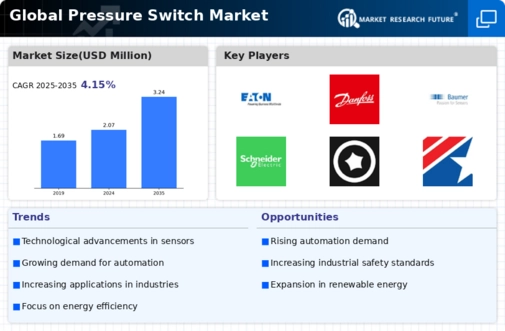Market Trends
Key Emerging Trends in the Pressure Switch Market
In the realm of HVAC (heating, ventilation, and air conditioning) systems, the crucial role played by pressure switches cannot be overstated. These protective devices, available in both high- and low-pressure variants, are instrumental in safeguarding HVAC systems, particularly compressors, from adverse conditions. Their multifaceted functionality includes protecting against high pressure and low refrigerant situations, controlling condenser fan cycling, and preventing the system from operating under unfavorable conditions such as clogged vents, dirty filters, or compromised condenser coils.
High-pressure switches act as sentinels, intervening when the pressure in the HVAC system reaches levels that could potentially harm the compressor. On the other hand, low-pressure switches come into play when the refrigerant levels drop below the optimal range, triggering a protective response to prevent damage to the system. Additionally, these switches contribute to the efficient operation of condenser fans, ensuring that they cycle appropriately to maintain optimal performance.
The market for HVAC pressure switches offers a diverse array of options, with variations based on the technology employed in the systems. The distinction between conventional and condensing technologies influences the design and configuration of pressure switches. For example, in a single-stage conventional system, a single hose connects the draft inducer fan to the pressure switch. In a single-stage condensing system, the pressure switch features two hoses. In a more complex two-stage system, two pressure switches may be employed, and a modulating system could incorporate three pressure switches. This diversity in configurations allows pressure switches to cater to the specific needs of various HVAC setups, ensuring a tailored approach to system protection and efficiency.
The proliferation of smart homes is a significant factor influencing the demand for advanced HVAC systems and, consequently, pressure switches. Smart homes leverage intelligent technologies to enhance energy efficiency, user comfort, and system control. Pressure switches play a vital role in this ecosystem, contributing to the seamless operation and protection of HVAC systems within smart homes. The integration of pressure switches in these smart environments ensures optimal performance, energy conservation, and enhanced longevity of HVAC components.
Reducing operating costs is a key consideration for both residential and commercial entities, and pressure switches contribute to achieving this objective in HVAC systems. By preventing the system from operating under conditions that could lead to inefficiency or damage, pressure switches play a pivotal role in minimizing maintenance costs and prolonging the lifespan of HVAC equipment. This cost-effectiveness, coupled with the demand for energy-efficient temperature control systems, further drives the adoption of pressure switches in the HVAC market.
Government initiatives and schemes aimed at incentivizing the replacement of outdated HVAC systems contribute to the growing demand for pressure switches. As governments worldwide prioritize energy efficiency and environmental sustainability, there is a concerted effort to encourage the adoption of modern, eco-friendly HVAC technologies. Pressure switches, with their role in enhancing system efficiency and preventing unnecessary wear and tear, align with the objectives of these initiatives, leading to increased adoption in both residential and commercial sectors.










Leave a Comment